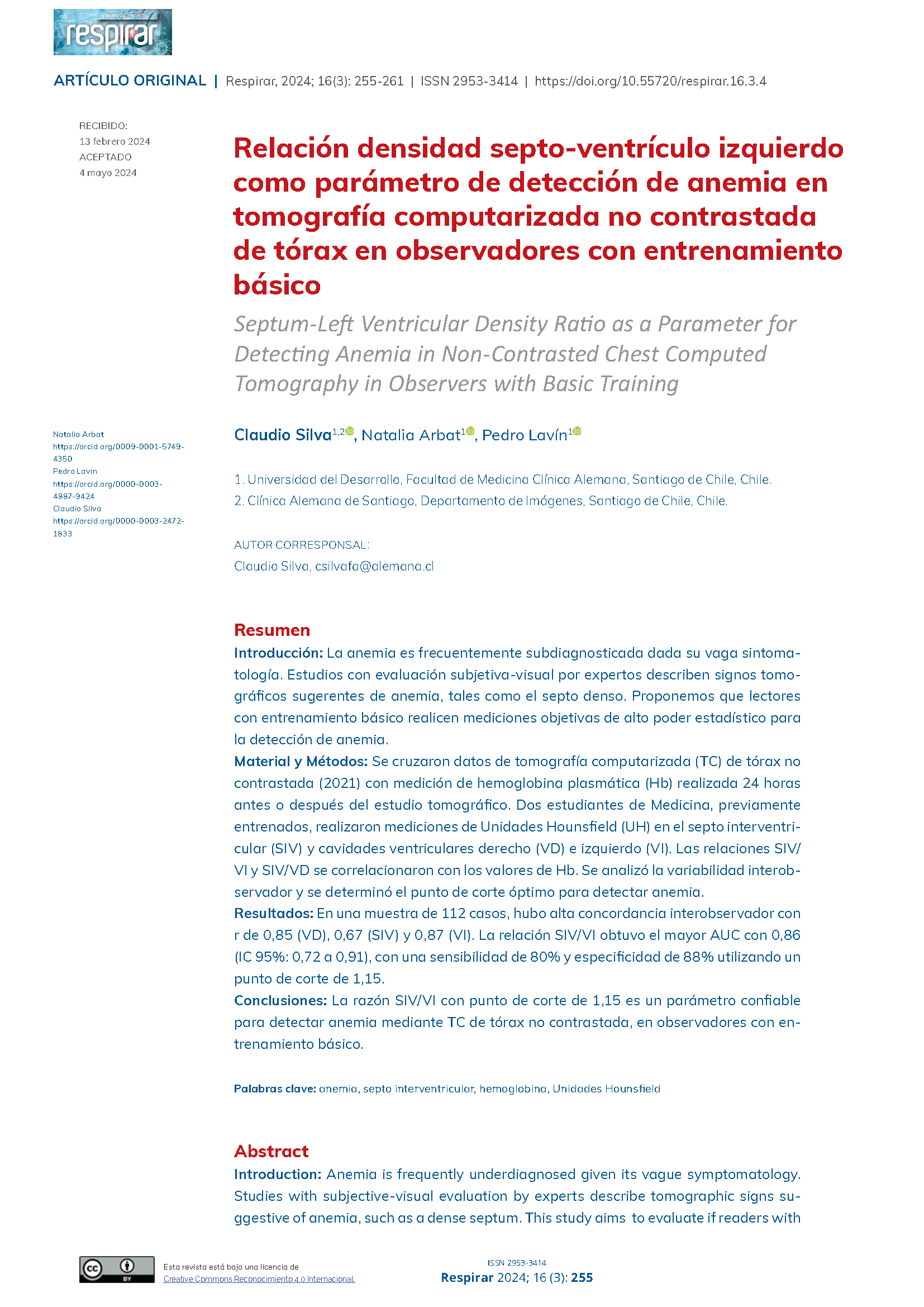Septum-Left Ventricular Density Ratio as a Parameter for Detecting Anemia in Non-Contrasted Chest Computed Tomography in Observers with Basic Training
Main Article Content
Abstract
Introduction: Anemia is frequently underdiagnosed given its vague symptomatology. Studies with subjective-visual evaluation by experts describe tomographic signs suggestive of anemia, such as a dense septum. This study aims to evaluate if readers with basic training can perform high statistical value measurements for anemia detection.
Material and Methods: Data of non-contrast thoracic computed tomography (CT) (2021) with a measurement of plasma hemoglobin (Hb) performed 24 hours before or after the CT were identified. Two previously trained medical students performed measurements of Hounsfield Units (HU) on the interventricular septum (IVS) and right (RV) and left (LV) ventricular cavities. The SIV/VI and SIV/VD ratios were correlated with Hb values. Interobserver variability was analyzed and the optimal cut-off point to detect anemia was determined.
Results: In a sample of 112 cases, there was a high interobserver correlation with r of 0.85 (VD), 0.67 (SIV), and 0.87 (VI). SIV/VI ratio obtained the highest AUC with 0.86 (95% CI: 0.72 to 0.91), with a sensitivity of 80% and specificity of 88% using a cut-off point of 1.15.
Conclusions: The SIV/VI ratio with a cut-off point of 1.15 is a reliable parameter to detect anemia using non-contrast chest CT in observers with basic training.
Downloads
Article Details

This work is licensed under a Creative Commons Attribution 4.0 International License.
References
Guzmán Llanos MJ, Guzmán Zamudio JL, Llanos de los Reyes-García MJ. Significado de la anemia en las diferentes etapas de la vida. Enfermería global 2016; 15 (43): 407-418.
GBD 2021 Anaemia Collaborators. Prevalence, years lived with disability, and trends in anaemia burden by severity and cause, 1990-2021: findings from the Global Burden of Disease Study 2021. Lancet Haematol 2023; 10 (9): 713-734. Doi: 10.1016/S2352-3026(23)00160-6.
Stevens G, Paciorek C, Flores-Urrutia M et al. National, regional, and global estimates of anaemia by severity in women and children for 2000-19: a pooled analysis of population-representative data. Lancet Global Health 2022; 10: 627-639. Doi: 10.1016/S2214-109X(22)00084-5.
Zhou QQ, Yu YS, Chen YC et al. Optimal threshold for the diagnosis of anemia severity on unenhanced thoracic CT: A preliminary study. Eur J Radiol 2018;108:236-241. Doi: 10.1016/j.ejrad.2018.10.007.
Title RS, Harper K, Nelson E, Evans T, Tello R. Observer performance in assessing anemia on thoracic CT. AJR Am J Roentgenol 2005;185(5):1240-4. Doi: 10.2214/AJR.04.1171.
Lan H, Nishihara S, Nishitani H. Accuracy of computed tomography attenuation measurements for diagnosing anemia. Jpn J Radiol 2010;28(1):53-7. Doi: 10.1007/s11604-009-0385-5.
Foster M, Nolan RL, Lam M. Prediction of anemia on unenhanced computed tomography of the thorax. Can Assoc Radiol J 2003;54(1):26-30.
Mahalawat A, Braggs A, Mynalli S. Prediction of Anaemia using Unenhanced Computed Tomography of Thorax: A Cross-sectional Study. IJARS 2021; 10: 14-17. Doi: 10.7860/IJARS/2021/47674.2664.
Pickhardt PJ. Value-added Opportunistic CT Screening: State of the Art. Radiology 2022; 303(2): 241-254. Doi: 10.1148/radiol.211561.
